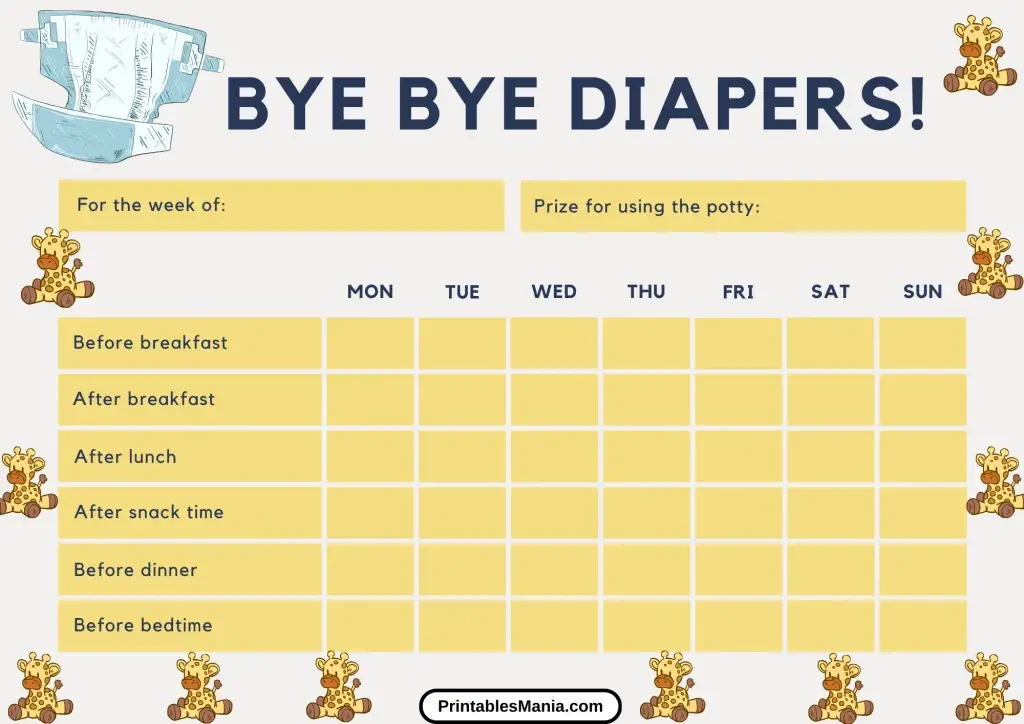Embark on the potty training journey with our range of free and engaging potty chart printables. Designed to make the transition from diapers to potty a fun and rewarding experience for your little one, our potty charts come in various themes and styles to suit your child’s interests and your parenting style.
Why Use a Potty Chart?
Potty charts are a fantastic tool to motivate toddlers during the potty training process. They help children visualize their progress and achievements, making the experience positive and encouraging. Each time your child successfully uses the potty, they get to add a sticker or mark the chart, which boosts their confidence and enthusiasm.
What You Will Find Here
- Variety of Designs: Choose from a wide range of themes including superheroes, animals, princesses, vehicles, and more.
- Customizable Options: Find charts that you can customize according to your child’s potty training needs.
- Tips for Success: Gain insights on how to effectively use potty charts to make potty training stress-free and enjoyable for both you and your child.
Start your potty training journey today with our printable potty charts and watch your child grow in confidence and independence. Browse our collection to find the perfect chart for your little one!














Step-by-Step Guide to Potty Training
Potty training is a significant milestone in your toddler’s development. Using a potty chart can make the process more fun and engaging for your child. Here’s a step-by-step guide to help you navigate this journey successfully:
1. Introduce the Potty Chart Start by explaining to your child what a potty chart is and how it will be used. Show them the chart and explain that each time they use the potty, they will get to place a sticker or mark on the chart. This visual aid helps them understand their progress and motivates them to keep trying.
2. Set Up a Routine Establish regular potty times throughout the day. This could be first thing in the morning, after meals, and before bedtime. Encourage your child to sit on the potty during these times, even if they don’t feel the need to go. Consistency helps reinforce the habit.
3. Reward Success Every time your child successfully uses the potty, let them place a sticker or mark on the chart. Celebrate these small victories with lots of praise and excitement. The immediate reward of a sticker and your positive reinforcement can make a big difference in keeping your child motivated.
4. Celebrate Milestones Set small milestones, such as a full row of stickers or a week of dry days, and celebrate them. You could offer a small reward, like a new book or a special outing, to mark these achievements. Celebrating milestones helps your child feel proud of their progress.
5. Stay Positive Potty training can have its ups and downs. It’s important to stay positive and patient, even if there are setbacks. Avoid scolding or showing frustration if your child has accidents. Instead, encourage them to try again and reassure them that they will get the hang of it.
Tips for Successful Potty Training
Potty training can be challenging, but with the right approach, it can also be a positive experience for both you and your child. Here are some tips to help you along the way:
1. Be Consistent Consistency is key to successful potty training. Stick to a routine and use the potty chart regularly. The more consistent you are, the quicker your child will learn what is expected.
2. Choose the Right Time Make sure your child is ready for potty training. Look for signs of readiness such as staying dry for longer periods, showing interest in using the potty, and being able to follow simple instructions. Starting too early can lead to frustration for both you and your child.
3. Use Positive Reinforcement Praise and encouragement go a long way in potty training. Celebrate your child’s efforts and successes with lots of positive reinforcement. This helps build their confidence and makes them more likely to continue trying.
4. Make it Fun Turn potty training into a fun activity. Use colorful and engaging potty charts, sing potty training songs, or read books about potty training. The more enjoyable the process, the more willing your child will be to participate.
5. Stay Patient Every child learns at their own pace, so it’s important to stay patient and avoid pressuring your child. Some children may take longer to potty train than others, and that’s perfectly normal. Be supportive and patient, and celebrate their progress, no matter how small.
By following these steps and tips, you can make potty training a positive and successful experience for your child. Remember, patience and consistency are key, and soon your child will be proudly using the potty like a pro.



